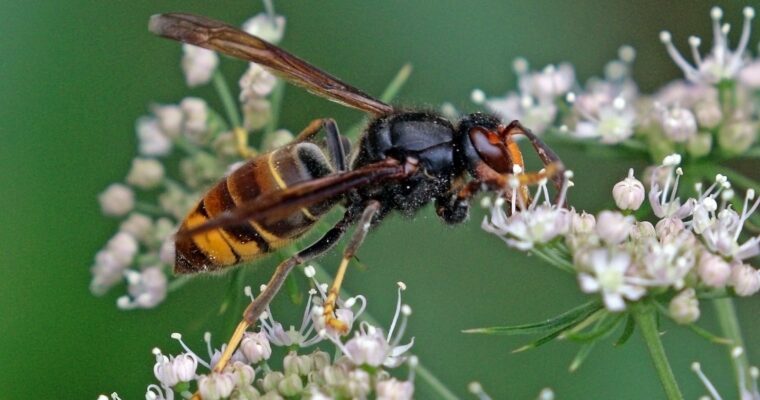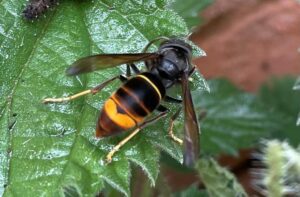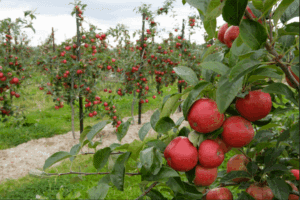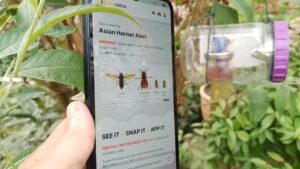Protect our pollinators and keep the Kent Downs buzzing

13th August 2025
Across the orchards, meadows, and country parks of the Kent Downs, pollinators are quietly at work. Bees, butterflies, hoverflies and moths help flowers bloom, fruit set and seeds spread. They’re the unseen workforce that keeps our countryside, farms and gardens alive.
But a species is putting this balance under threat:
There’s no need to panic, but there is a real need to stay alert. By recognising the signs and reporting what you see, you can help protect pollinators across the Kent Downs.
What is an Asian Hornet
Originally from Southeast Asia, the Asian hornet has been moving steadily across Europe for the past20 years. First recorded in France in 2004, it has since spread to neighbouring countries and reached the UK.
Until recently, sightings here were rare, and any nests found were removed quickly. But this year saw a sharp increase in confirmed sightings and nests.

Credits: National Bee Unit
Asian Hornets are slightly smaller than our native hornet. They are easy to identify if you know what to look for:
- a mostly dark body,
- a single orange band near the tail
- and distinctive yellow tips on their legs – giving them the nickname ‘yellow-legged hornet’.
Unlike our native hornets, they hunt quickly hunters and often hover outside beehives to catch honeybees. One nest can destroy tens of thousands of pollinators in a single season.
They’re not usually aggressive towards people unless disturbed, but for our bees, butterflies, and the crops and wildlife that depend on them, they’re a serious threat.
What it matters in the Kent Downs
The Kent Downs National Landscape is one of the UK’s richest areas for pollinators. Orchards, chalk grasslands, hedgerows and wildflower rich verges provide essential food and nesting sites.
Kent is also a leading fruit-growing region, and pollinators support much more than wildlife – the keep farms productive and local economies strong.

Because the Asian hornet is still relatively new to the UK, early action matters. The sooner we detect new hornets, the greater the chance of preventing them from spreading.
How you can help
Late summer and early autumn are the best times to look out for Asian Hornets. You might see them:
- feeding on ivy flowers, fallen fruit, or nectar-rich garden plants
- hovering near beehives, hunting honeybees.
If you think you’ve spotted one:
- Take a clear photograph – if it’s safe to do so.
- Report it using the free Asian Hornet Watch app (available on iOS and Android), or by emailing your photo and location to alert_nonnative@ceh.ac.uk.

Please don’t try to remove or handle nests yourself. Trained teams are ready to respond safely.
What we’re doing
We’re working with local beekeepers, farmers, volunteers and national experts to track sightings, raise awareness and remove nests safely. Our Making Trapping Happen project builds networks of monitoring traps and collects vital data to protect pollinators across the Kent Downs.
Working together for pollinators
The Asian hornet is not yet established in the UK, and public awareness is one of the main reasons why every sighting reported helps keep it that way. Whether you’re a walker, gardener, farmer or bee keeper, simply being observant and reporting what you see can make a big difference.
The Kent Downs has always relied on people who care for its wildlife and landscapes. Together, we can keep it thriving.
The Making Trapping Happen project is made possible thanks to funding from Defra’s Farming In Protected Landscapes programme.
Popular articles
The Best Viewpoints in the Kent Downs
Searching for incredible views? Look no further! We've rounded up the best…
Top 5 bluebell walks in the Kent Downs
If you're looking for inspiration on the best places for some bluebell…
Lambing season in the Kent Downs
Discover the importance of lambing season in the Kent Downs and find…
